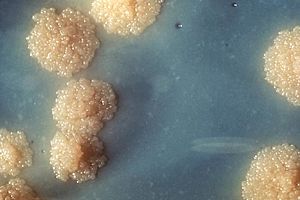Mycobacterium facts for kids
Quick facts for kids Mycobacterium |
|
|---|---|
 |
|
| TEM micrograph of M. tuberculosis. | |
| Scientific classification | |
| Kingdom: | |
| Phylum: | |
| Order: |
Actinomycetales
|
| Suborder: |
Corynebacterineae
|
| Family: |
Mycobacteriaceae
|
| Genus: |
Mycobacterium
|
Mycobacterium is a group of tiny living things called bacteria. There are about 100 different kinds, or species, of Mycobacterium. Some of these bacteria can cause serious sicknesses in animals, including humans. Two well-known diseases they cause are tuberculosis (from Mycobacterium tuberculosis) and leprosy (from Mycobacterium leprae).
Sometimes, these bacteria can live inside a body without making the person sick right away. Many people have M. tuberculosis in their bodies but don't show any signs of illness.
It can be hard to treat infections caused by Mycobacterium. These bacteria are very tough because of their special outer layer, called a cell wall. This cell wall helps them survive against many things, like strong chemicals or even some antibiotics.
The word "myco" comes from an old Greek word meaning "fungus". When these bacteria grow in a lab, they can look a bit like moulds, which are a type of fungus.
Contents
What Are Mycobacteria?
Mycobacteria are a special type of bacteria. They are known for having a very strong and waxy cell wall. This wall makes them different from many other bacteria. It helps them survive in harsh conditions.
These bacteria are found all over the world. They can live in soil, water, and even inside living things. Some kinds of mycobacteria are harmless. Others can cause serious health problems.
Diseases Caused by Mycobacteria
Some Mycobacterium species are known to cause important diseases in humans. The two most famous are tuberculosis and leprosy.
Tuberculosis
Tuberculosis (often called TB) is a serious disease caused by Mycobacterium tuberculosis. This bacterium usually attacks the lungs. However, it can also affect other parts of the body, like the kidneys, spine, or brain.
TB can spread when an infected person coughs or sneezes. Tiny droplets carrying the bacteria go into the air. Other people can then breathe them in. Not everyone who gets the bacteria becomes sick. Some people have a "latent" infection, meaning the bacteria are in their body but are not active. They don't feel sick or spread the disease.
If the bacteria become active, the person gets "active TB disease." Symptoms can include a bad cough, chest pain, fever, weight loss, and night sweats. TB can be treated with special antibiotics, but it takes a long time, often six months or more.
Leprosy
Leprosy is another long-lasting infection. It is caused by Mycobacterium leprae. This disease mainly affects the skin, nerves, and eyes. It can also affect the upper breathing passages.
Leprosy spreads slowly between people. It is not as easy to catch as TB. Most people are naturally immune to it. For those who do get it, the disease can cause skin patches, numbness, and muscle weakness. If not treated, it can lead to permanent damage.
Luckily, leprosy can be cured with a combination of antibiotics. Treatment usually lasts for several months to a year.
Why Are Mycobacteria Hard to Treat?
Treating infections from Mycobacterium can be tricky. There are a few reasons for this:
- Tough Cell Wall: As mentioned, their waxy cell wall is very strong. It acts like a shield. This shield makes it hard for many common antibiotics to get inside the bacteria and kill them.
- Slow Growth: Mycobacteria grow very slowly. This means that antibiotics need to be taken for a long time to kill all the bacteria. If treatment stops too soon, the infection can come back.
- Antibiotic Resistance: Over time, some mycobacteria have become resistant to certain antibiotics. This means the medicine no longer works against them. This is a big problem because it makes infections even harder to cure. Doctors have to use different, stronger medicines.
Scientists are always working to find new ways to fight these tough bacteria.
Images for kids
-
TEM micrograph of M. tuberculosis.
See also
 In Spanish: Mycobacterium para niños
In Spanish: Mycobacterium para niños




